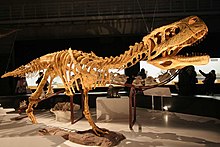Aucasaurus
| Aucasaurus | |
|---|---|

| |
| Mounted skeleton reconstruction | |
| Scientific classification | |
| Domain: | Eukaryota |
| Kingdom: | Animalia |
| Phylum: | Chordata |
| Clade: | Dinosauria |
| Clade: | Saurischia |
| Clade: | Theropoda |
| Family: | †Abelisauridae |
| Tribe: | †Carnotaurini |
| Genus: | †Aucasaurus Coria et al., 2002 |
| Type species | |
| †Aucasaurus garridoi Coria et al., 2002
| |
| Synonyms | |
| |
Aucasaurus is a
In 2009, Novas suggested that Aucasaurus garridoi might be a
Discovery
Aucasaurus is known from finds in the
Description


Aucasaurus was a medium-sized abelisaur, measuring 5.5–6.2 m (18–20 ft) long and weighing approximately 700 kg (1,500 lb).[5][8][9] Its skull was not as short or as deep-snouted as that of Carnotaurus. Also, instead of horns, it had a pair of low ridges above each eye.[7]
Forelimbs and hands
The small arms of Aucasaurus were also like that of its horned relative, but were proportionally longer due to its small size, and the bones lacked the bony processes and some unusual proportions present in Carnotaurus. The
Braincase

A study was done on the braincase of Aucasaurus in 2015 by Ariana Paulina-Carabajal and Cecilia Succar, in which the skull material was scanned using a medical CT machine. Virtual three-dimensional inner ear and cranial endocasts were obtained and visualized using the imagine software at the
Pathology

The 5th and 6th holotype tail vertebrae of Aucasaurus provide evidence of failed developmental vertebral segmentation, so two of the vertebrae are fused. Baiano et al. (2024) interpret this as a
Classification
Aucasaurus was closely related to Carnotaurus and they are united in the Carnotaurini.[7]
Below is a cladogram by Canalle et al. in 2009.[6]
| Carnotaurinae |
| ||||||
See also
References
- ^ The Theropod Database on Aucasaurus
- S2CID 131148538.
- ISBN 978-0822567912.
- ISBN 9780253352897.
- ^ ISBN 9781400836154.
- ^ S2CID 23619863.
- ^ ISBN 978-0-7566-9910-9.
- .
- PMID 32983636.
- .
- PMID 38291378.
